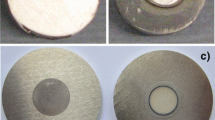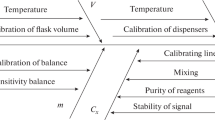Abstract
Multi-step wet analytical procedures were tested on gallium samples of different purity grades. Results obtained were compared with those of spark source mass spectrometry (SSMS) and glow discharge mass spectrometry (GDMS). It was found that multi-step procedures, as applied, with preconcentration factors of 200 are suitable to determine most of the detectable elements in high purity gallium in the ng/g-range. The results thus obtained agree well with those obtained by mass spectrometry. The sensitivity of the multi-step and mass spectrometry methods is not sufficient to detect traces of the investigated elements in super purity gallium, i.e. better than 6 N. These qualities can be differentiated, however, by single crystal resistivity measurement.
Similar content being viewed by others
References
A. Dornemann, H. Kleist,Fresenius' Z. Anal. Chem. 1978,291, 349.
C. K. Ramamurty, G. Kaiser, G. Tölg,Mikrochim. Acta [Wien] 1980,I, 79.
E. Jackwerth, J. Messerschmidt,Anal Chim. Acta 1976,87, 341.
O. G. Koch, G. A. Koch-Dedic,Handbuch der Spurenanalyse, Teil 2, Springer, Berlin-Heidelberg-New York, 1974, pp. 1063 ff.
P. Tschöpel, L. Kotz, W. Schulz, M. Veber, G. Tölg,Fresenius' Z. Anal. Chem. 1980,302, 1.
Author information
Authors and Affiliations
Rights and permissions
About this article
Cite this article
Kudermann, G., Blaufuß, KH. Characterization of high purity gallium. Mikrochim Acta 91, 269–274 (1987). https://doi.org/10.1007/BF01199502
Received:
Issue Date:
DOI: https://doi.org/10.1007/BF01199502




